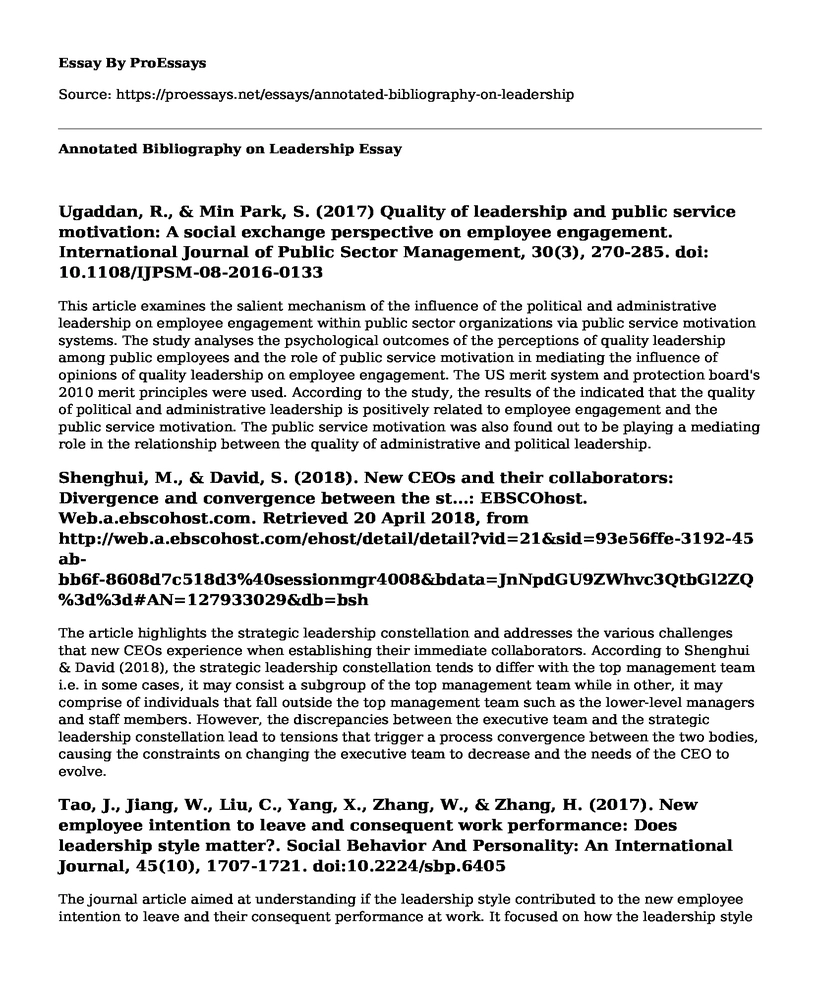Ugaddan, R., & Min Park, S. (2017) Quality of leadership and public service motivation: A social exchange perspective on employee engagement. International Journal of Public Sector Management, 30(3), 270-285. doi: 10.1108/IJPSM-08-2016-0133
This article examines the salient mechanism of the influence of the political and administrative leadership on employee engagement within public sector organizations via public service motivation systems. The study analyses the psychological outcomes of the perceptions of quality leadership among public employees and the role of public service motivation in mediating the influence of opinions of quality leadership on employee engagement. The US merit system and protection board's 2010 merit principles were used. According to the study, the results of the indicated that the quality of political and administrative leadership is positively related to employee engagement and the public service motivation. The public service motivation was also found out to be playing a mediating role in the relationship between the quality of administrative and political leadership.
Shenghui, M., & David, S. (2018). New CEOs and their collaborators: Divergence and convergence between the st...: EBSCOhost. Web.a.ebscohost.com. Retrieved 20 April 2018, from http://web.a.ebscohost.com/ehost/detail/detail?vid=21&sid=93e56ffe-3192-45ab-bb6f-8608d7c518d3%40sessionmgr4008&bdata=JnNpdGU9ZWhvc3QtbGl2ZQ%3d%3d#AN=127933029&db=bsh
The article highlights the strategic leadership constellation and addresses the various challenges that new CEOs experience when establishing their immediate collaborators. According to Shenghui & David (2018), the strategic leadership constellation tends to differ with the top management team i.e. in some cases, it may consist a subgroup of the top management team while in other, it may comprise of individuals that fall outside the top management team such as the lower-level managers and staff members. However, the discrepancies between the executive team and the strategic leadership constellation lead to tensions that trigger a process convergence between the two bodies, causing the constraints on changing the executive team to decrease and the needs of the CEO to evolve.
Tao, J., Jiang, W., Liu, C., Yang, X., Zhang, W., & Zhang, H. (2017). New employee intention to leave and consequent work performance: Does leadership style matter?. Social Behavior And Personality: An International Journal, 45(10), 1707-1721. doi:10.2224/sbp.6405
The journal article aimed at understanding if the leadership style contributed to the new employee intention to leave and their consequent performance at work. It focused on how the leadership style contributes to the relationship between the new employees at NEIL to leave the company as well as the effect on their work performance. The focus group was on NEIL with the new employees at a large firm in China. The parameters under consideration include the leadership styles used and the work performance of the employees. According to Jun Tao et al. (2017), abusive leadership increases the effect of new employee intention to leave and their resultant work performance whereas application of ethical leadership neutralizes the effect.
Vallaster, C., & Chernatony, L. (2006). Internal brand building and structuration: The role of leadership. European Journal of Marketing, 40(7/8), 761-784. doi: 10.1108/03090560610669982
The article clarifies the relationship between organizational structures and individual brands in supporting organizational behavior. It models the social transformational processes and outlines the importance of leadership in the internal brand building process. The study includes the broader range of human resource and leadership-related aspects found in branding literature. The findings of the paper provide empirical insights on how change is brought about in the process of internal brand building. According to Vallaster and Chernatony (2006), successful leaders act as "integrating forces" on two levels: integrating the structures of corporate identity and mediating between the organizational branding structures and the individual employee.
Wallace, Chernatony & Buil (2013). Building bank brands: How leadership behavior influences employee commitment. Journal Of Business Research, 66(2), 165-171. doi:10.1016/j.jbusres.2012.07.009
The article analyses how leadership behavior influences employee commitment. The study explored bank leaders and incorporated data from 438 employees from a leading Irish bank to identify the optimal leadership style for employee commitment. According to the authors, the front line employees are critical to the success of service brands since their performance brings the brand promises to life. Employee commitment, therefore, influences their brand adoption and brand-supportive behavior in the course of service encounters. Effective leadership, therefore, fosters employee commitment and enhances the brand supportive behaviors. The study explores the initiating structure leader behavior and considerate leader behavior and their effectiveness in enhancing employee commitment.
References
Daniel, N. (2018). LEADERSHIP AND THE LOGIC OF ABSURDITY: EBSCOhost. Web.a.ebscohost.com. Retrieved 20 April 2018, from http://web.a.ebscohost.com/ehost/detail/detail?vid=22&sid=93e56ffe-3192-45ab-bb6f-8608d7c518d3%40sessionmgr4008&bdata=JnNpdGU9ZWhvc3QtbGl2ZQ%3d%3d#AN=128622360&db=bsh
Popli,S., & Rizvi,I. (2017) Leadership style and service orientation: The catalytic role of employee engagement. Journal of Service Theory and Practice, 27(1), 292-310, doi.org/10.1108/JSTP-07-2015-0151
Ugaddan, R., & Min Park, S. (2017) Quality of leadership and public service motivation: A social exchange perspective on employee engagement. International Journal of Public Sector Management, 30(3), 270-285. doi: 10.1108/IJPSM-08-2016-0133
Shenghui, M., & David, S. (2018). New CEOs and their collaborators: Divergence and convergence between the st...: EBSCOhost. Web.a.ebscohost.com. Retrieved 20 April 2018, from http://web.a.ebscohost.com/ehost/detail/detail?vid=21&sid=93e56ffe-3192-45ab-bb6f-8608d7c518d3%40sessionmgr4008&bdata=JnNpdGU9ZWhvc3QtbGl2ZQ%3d%3d#AN=127933029&db=bsh
Tao, J., Jiang, W., Liu, C., Yang, X., Zhang, W., & Zhang, H. (2017). New employee intention to leave and consequent work performance: Does leadership style matter?. Social Behavior And Personality: An International Journal, 45(10), 1707-1721. doi:10.2224/sbp.6405
Vallaster, C., & Chernatony, L. (2006). Internal brand building and structuration: The role of leadership. European Journal of Marketing, 40(7/8), 761-784. doi: 10.1108/03090560610669982
Wallace, Chernatony & Buil (2013). Building bank brands: How leadership behavior influences employee commitment. Journal Of Business Research, 66(2), 165-171. doi:10.1016/j.jbusres.2012.07.009
Cite this page
Annotated Bibliography on Leadership. (2022, May 09). Retrieved from https://proessays.net/essays/annotated-bibliography-on-leadership
If you are the original author of this essay and no longer wish to have it published on the ProEssays website, please click below to request its removal:
- Reflective Essay Example: Team Management
- U.S. Core Values Essay
- Leader Rewards and Punishment Behavior Essay
- Essay Sample on Corporate Cultures
- Preliminary Report: Project Mgr Roles, Objectives & Responsibilities - Essay Sample
- Essay Sample on Gap Inc.'s Competitive Strategy: Differentiation & Best-Cost Provider
- Essay Example on Maximizing Cost Efficiency: The Benefits of Life-Cycle Cost Analysis (LCCA).







